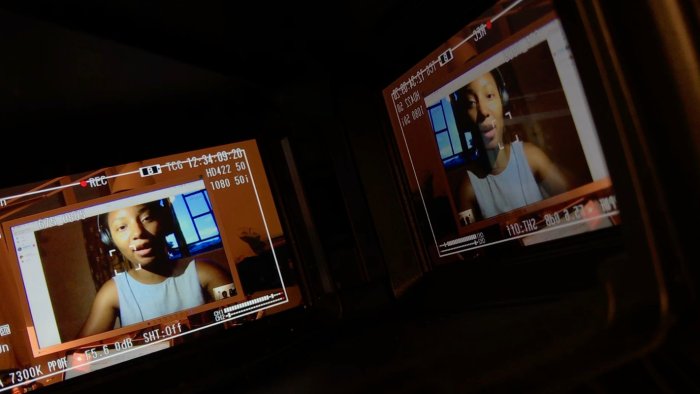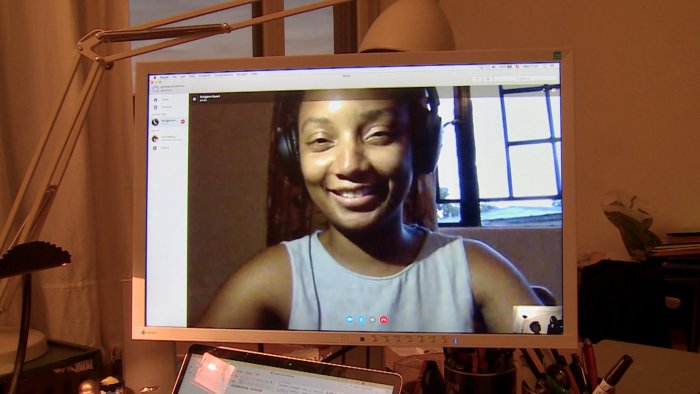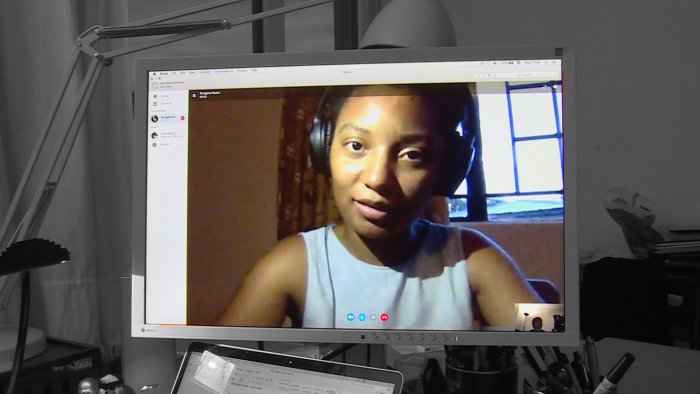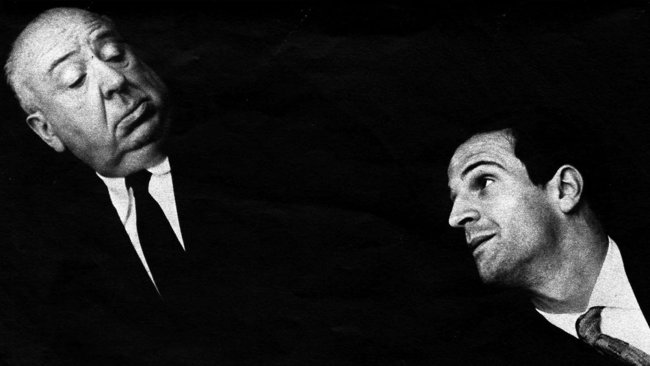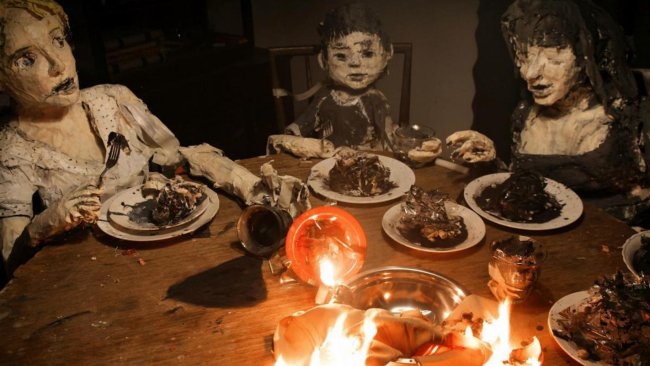I Am Not a Witch | Rungano Nyoni
[…] She [Rungano Nyoni] masterfully abstracts the nonsensical features of witchcraft, from irrational belief to absurd ritual, and stylises some of the characters into hyperbolic performers akin to bombastic Pentecostal preachers: all colour, all gesture, fake.
[…] There are several striking visual moments in the film as the camera often frames in mid-shot with duration the arid landscape, scorched by the endless burning sun and lack of rain. We are brought in close to Shula’s interior with many lingering moments on her remarkable face: quiet, with desperation brewing.
Text: Jodie McNeilly | Audio/Video: Ruth Baettig
There is nothing more confronting than atrocities taking place in nations where children are falsely stigmatised or abused as a result of superstitious beliefs. Witchcraft is one such belief that leads to violence against women and children on a disturbing scale. Even within contexts where the modern world is materially apparent and democratic processes appear to be in place, archaic and dangerous attitudes continue to thrive within communities and families, failing to protect the young and vulnerable.
Rungano Nyoni’s I am Not a Witch presents this topic in a form that provokes disbelief, despair, some laughter and, as a dangling coda, hope. She masterfully abstracts the nonsensical features of witchcraft, from irrational belief to absurd ritual, and stylises some of the characters into hyperbolic performers akin to bombastic Pentecostal preachers: all colour, all gesture, fake. This is particularly true of the Government Official for the “Ministry of Tourism and Religious Belief” (Henry B.J. Phiri) who is responsible for managing the affairs of the witch camp, a kind of labour camp that holds captive the women who have been stigmatised. His entourage are similarly exaggerated and consists of a witch doctor (James Manaseh) who confirms whether a woman is a witch or not by rattling and shaking his rake thin body in oversized underwear after slitting the throat of a chicken, and a former-witch (Nancy Mulilo) who has gained “respectability” by becoming his wife and doormat.
Their overblown figurations are a fitting representation of the unsubtle excesses resulting from traditional symbols colliding with consumerist ones that emerge from capitalist-fuelled new democracies only partially subsuming feudal, tribal states. Clothing, accessories, mobile phones all mark the insidious infiltration of the material minus the Western practice of justice, freedom and equality. The blend of traditional and modern beliefs precipitates the rhythm and direction of exploitation; the young and innocent suffer the most. Nyoni opens the film with a minibus taking tourists to observe the African witches, who like occidental exotics perform their wailing, chants and face grimaces on cue. She clearly shows the absorption of globalisation in its most grotesque form: tourism at the expense of a nation’s living trauma.
These characters also offer a contrastive lightness and surface to the heaviness and depth that the female protagonist, 9 year old Shula (Margaret Mulubwa) brings to the screen. Her large penetrating eyes elicit pain, fear and innocence, a combination that begets mysteriousness and ultimately suspicion. Exiled or abandoned, Shula (like all witch-children) is a scapegoat for the community’s bad luck and misfortunes. Her only safety being the confine of the witch camp and tethering of her back to a long white ribbon wound onto a large wooden spool and attached to a shiny orange semi-trailer. Paradoxically the camp takes away her freedom while preserving her life; it is both prison and refuge.
On entering the camp, the once mute Shula opens up to the warmth of the other women who now care for the orphan. Shula becomes the “short” arm of justice in the community by pointing out the guilty in petty crimes. Trucked about in elaborate costumes constructed from bush detritus and wearing face makeup, she is forced to perform her witch duties as a “soldier of the government”. The film takes up the theme of freedom and is explored through the thoughts and action of a child. It is an inhumane responsibility, as it always is when any child has to seriously question their freedom. The women, whether they believe it or not, persist with the false belief of becoming a goat if they cut the ribbon, a choice that is given to Shula on initiation into the camp. Only she meditates on this possible mode of freedom that is in reality (as the women are well aware) an absurd euphemism for death at the hand of the fear mongers in the community. Once accused as a witch, the idea of civil freedom disappears and one can only ask: what is the maximum freedom I can have? Nyoni allows the child to hope and us to sweat with this dilemma: cut the ribbon and be free as a (dead) goat; or stay tied to the ribbon forever in safety and solidarity. In exercising (at least) her free-will, Shula chooses death. Her small body is dumped by two boys in the dry soil where the women toil all day on the ends of their ribbons. From the deep sadness of this scene we are forced to ask whether or not it is a relief. For Shula, it is very clear that the tattoos she received on her forehead healed, but the corrosive wounds of stigmatisation never did.
There are several striking visual moments in the film as the camera often frames in mid-shot with duration the arid landscape, scorched by the endless burning sun and lack of rain. We are brought in close to Shula’s interior with many lingering moments on her remarkable face: quiet, with desperation brewing. She is an emblem of innocence that shines bright in the dusty grey-green pastels of Zambia’s rural places and villages. The orange truck, with the theatricality of a mardi-gras float, transports the women from field to field with ribbons flapping on their backs – a promise to the community that they are unable to fly. The truck also performs an absent beauty in the final scene, understood to be a prophetic postscript rather than part of the narrative. The women are no longer present, they are cut adrift and buoyed in freedom by the solidarity of their choral singing. The ribbons move frenetically in the breeze. The truck and arrangement of spools are like a rotting carcass; its sinews snapped and forever broken.
Nyoni’s filmmaking provides enough insight into the topic without her stumbling into the straightness of a documentary or the starkness of realism. She is able to entertain with stylised humour, make visual choices that promotes the beauty of these places of accusation, incarceration and death, and eases us into understanding the reality of this ongoing atrocity without defaulting to any graphic violence. I look forward to Nyoni’s future works with great anticipation.
This article contains a third-party video. If you would like to watch the video, please adjust your settings.
Info
I Am Not a Witch | Film | Rungano Nyoni | FR-UK 2017 | 93’ | Black Movie Genève 2018
First published: January 26, 2018
